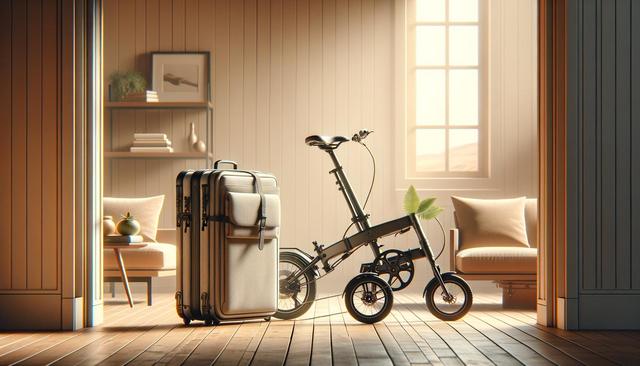Why Folding E-Bikes Stand Out
Folding e-bikes combine the benefits of electric assistance with a compact, foldable frame, making them an appealing choice for riders with limited storage space or frequent travel needs. Unlike traditional e-bikes, which can be bulky and difficult to transport, folding models offer a practical solution for commuters, apartment dwellers, and travelers. Their design allows the bike to collapse into a smaller footprint, often small enough to fit under a desk, in a car trunk, or on public transportation. This feature alone sets them apart when exploring the different types of e-bikes to determine which one is right for you.
In addition to portability, folding e-bikes tend to be lightweight, often constructed from materials like aluminum or carbon fiber. This makes them easier to carry when folded, whether up a flight of stairs or across a train platform. For urban dwellers or those with multi-modal commutes, this flexibility can significantly enhance the practicality of daily transportation.
Key Features to Consider
When evaluating folding e-bikes, several features should be taken into account to ensure the model fits your specific needs. While electric motor power and battery range are important across all e-bikes, folding variants come with additional considerations due to their compact design. Here are a few aspects to keep in mind:
- Folding Mechanism: How quickly and easily the bike folds can make a big difference in daily use.
- Weight: A lighter bike is easier to carry but may sacrifice some durability or battery capacity.
- Wheel Size: Smaller wheels are more compact but may affect ride stability and comfort.
- Frame Strength: Foldable frames must remain robust despite the hinge points.
These features contribute to the overall usability of a folding e-bike. Riders who prioritize convenience during storage or transport should weigh these factors carefully when comparing models.
Ideal Use Cases for Folding E-Bikes
Folding e-bikes are particularly well-suited for specific lifestyles and environments. Their convenience and mobility make them a top-rated choice for:
- Urban Commuting: Easily navigate city streets and bring the bike into your office or apartment.
- Public Transit Integration: Fold and carry your e-bike onto buses or subways, avoiding the need for bike racks.
- RV or Van Life: Store the bike in compact vehicles for mobility during travel stops.
- College Campuses: Fold and store between classes or in dorm rooms without hassle.
These use cases highlight the adaptability of folding e-bikes. They’re not just about saving space; they make active transportation possible in situations where a traditional e-bike might be too cumbersome.
Comparing Folding E-Bikes to Other Types
When exploring the different types of e-bikes, folding models offer a unique blend of portability and performance. Compared to cruiser or mountain e-bikes, folding models often have more compact frames and shorter range due to smaller batteries. However, they excel in environments where space is a premium. For example, cargo e-bikes are ideal for carrying goods but generally require large storage areas, whereas folding e-bikes can be stored in closets or under furniture.
Another consideration is ride comfort. While folding e-bikes may not offer the same suspension or tire size as fat tire or hybrid models, many feature adjustable seats and handlebars to accommodate different rider heights. Some even include comfort-focused features such as padded saddles and ergonomic grips, enhancing the ride experience despite their smaller form.
Ultimately, your choice depends on your specific needs. If space-saving and portability are top priorities, folding e-bikes offer a well-regarded alternative to bulkier models without compromising essential functionality.
Maintenance and Longevity
Keeping a folding e-bike in good condition requires attention to both its mechanical and electronic components. Regular maintenance ensures the bike remains safe and functional, especially given the additional joints and folding mechanisms that are not present in standard e-bikes. Key maintenance steps include:
- Hinge Inspection: Regularly check folding joints for wear or loosening, and apply lubricant as needed.
- Battery Care: Charge batteries according to manufacturer guidelines and avoid storing in extreme temperatures.
- Brake and Tire Checks: Ensure brakes are responsive and tires are properly inflated, especially before folding/unfolding.
With proper care, folding e-bikes can offer long-lasting performance. Their design emphasizes convenience, but that doesn’t mean cutting corners on quality. Many well-regarded models are built with durable parts and reliable electronics, making them a sound investment for frequent riders who value both mobility and dependability.
Conclusion: Is a Folding E-Bike Right for You?
Folding e-bikes hold a unique place in the e-bike landscape, offering a blend of compact design, electric assistance, and practical features tailored for convenience. Whether you’re a city commuter without much storage space, a frequent traveler looking for easy transport, or someone integrating bike riding with public transit, folding e-bikes can provide a flexible and efficient solution.
When exploring the different types of e-bikes to find the right fit, consider how and where you plan to ride. Folding e-bikes may not suit every terrain or need, but their standout qualities in portability and storage make them a strong contender for urban environments and on-the-go lifestyles. With thoughtful selection and proper maintenance, a folding e-bike can be a reliable companion for years to come.




Leave a Reply